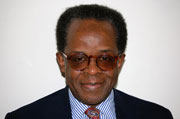
A license to kill Black men
By Lee A. Daniels, NNPA Columnist
From nearly the moment he was attacked by a New York City police officer July 18, the world has, via that chilling video, watched Eric Garner die.
Are we now about to see the “traditions” that led to his death and – thus far – have enabled his killer to escape justice die, too?
Moments after the news broke Dec. 3 that a New York City grand jury had voted not to indict the white police officer whom video showed had jumped Eric Garner from behind, ridden him to the sidewalk pavement and lain on his back while Garner, breathing heavily, frantically uttered “I can’t breathe!” nearly a dozen times, Garner’s stepfather spoke these bitter words: “It’s just a license to kill a Black man!”
Yes. That’s what such decisions in the past meant – the reaffirmation of the longstanding ‘tradition’ that police officers, especially white ones, who kill unarmed Black men, or women or children in questionable circumstances do not get indicted. Or, if indicted, they do not get convicted. That’s because the ‘traditional’ stance American police departments, North as well as South, have taken toward Black Americans has always been to control them, not protect them.
The issue that Eric Garner’s death – and all the police killings of Black Americans in questionable circumstances – has now made unavoidable is how to eliminate these two “traditions” from the practice of policing.
Daniel M. Donovan, Jr., the District Attorney of Staten Island, the city borough where Garner lived and was killed (Staten Island is the most conservative and least diverse borough of the city’s five boroughs; separated from the mainland by water, accessible only by ferry and bridges), couldn’t afford to allow the grand jury (grand juries are under the complete control of prosecutors) to indict the officer – and thus send the case to a jury trial – because the video of Eric Garner’s death is so damning. So he engaged the old tradition to produce a grand jury decision that showed the jurors had literally refused to act on what their eyes and common sense made plain.
Even some conservatives denounced the grand jury decision as a gross miscarriage of justice. Other conservatives, of course, stuck to the old tattered script that Blacks must always be blamed for their oppression. Among them was Charles Barkley, who’s become embarrassingly eager to use his basketball fame to become conservatives’ latest “Magic Negro.”
But the shock and anger that the decision immediately provoked may yet lead to undermining the tradition that lets cops who kill unjustifiably escape responsibility for their actions.
One reason for this hope is the recent tragic and infuriating series of police killing, wounding or accosting unarmed Black Americans in questionable circumstances. Those tragedies were shockingly underscored by two police killings that bracketed the decision of the Ferguson, Mo. grand jury not to indict the police officer who killed Michael Brown.
The first was the killing of Akai Gurley, a 28-year-old New Yorker, who, leaving a friend’s apartment in a New York City housing project, happened to step into its unlit stairway at the moment a rookie New York City cop was ascending it – with, police officials have said, his gun drawn for no apparent reason. As soon as Gurley opened the door to the stairway, the cop fired, killing him.
The second incident was a Cleveland police officer’s shooting to death 12-year-old Tamir Rice, who was playing in his neighborhood’s playground while waving a realistic-looking toy gun. The cop, whom official police records show shot the boy two seconds after arriving at the park, was later found to have compiled a record of serious emotional instability at his previous police-force job that should have disqualified him for police work anywhere.
That the Cleveland police force has a host of problems that reach far beyond this one officer was the subject of a scathing study of its practices the federal Department of Justice released last week as well. It declared that the department’s effectiveness and reputation were undermined by a pattern of “excessive use of deadly force, including shootings and head strikes with impact weapons” and the “employment of poor and dangerous tactics that place officers in situations where avoidable force becomes inevitable.”
There’s been significant recent evidence that whites and Latinos, too, don’t completely escape being physically brutalized by individual cops, either, while their superiors look the other way. But now the greater visibility of incidents of unjustifiable police violence against Blacks and of reports which find it’s driven by an institutional culture as well as individuals’ pathologies should make one thing obvious: it’s time for the “two traditions” to end.
